City opens evacuee centre after thousands flee wildfires Hundreds of residents remain in Pimicikamak as rescue flights begin
Read this article for free:
or
Already have an account? Log in here »
To continue reading, please subscribe:
Monthly Digital Subscription
$1 per week for 24 weeks*
- Enjoy unlimited reading on winnipegfreepress.com
- Read the E-Edition, our digital replica newspaper
- Access News Break, our award-winning app
- Play interactive puzzles
*Billed as $4.00 plus GST every four weeks. After 24 weeks, price increases to the regular rate of $19.00 plus GST every four weeks. Offer available to new and qualified returning subscribers only. Cancel any time.
Monthly Digital Subscription
$4.75/week*
- Enjoy unlimited reading on winnipegfreepress.com
- Read the E-Edition, our digital replica newspaper
- Access News Break, our award-winning app
- Play interactive puzzles
*Billed as $19 plus GST every four weeks. Cancel any time.
To continue reading, please subscribe:
Add Free Press access to your Brandon Sun subscription for only an additional
$1 for the first 4 weeks*
*Your next subscription payment will increase by $1.00 and you will be charged $16.99 plus GST for four weeks. After four weeks, your payment will increase to $23.99 plus GST every four weeks.
Read unlimited articles for free today:
or
Already have an account? Log in here »
Out-of-control wildfires raged on the doorsteps of northern Manitoba communities Thursday while officials tried to usher hundreds of remaining residents to safety, and military planes began airlifting some of the 17,000-plus evacuees to Winnipeg.
Pimicikamak Cree Nation was trying to get more than 750 residents out of the community after flames blocked some escape routes amid what was believed to be Manitoba’s largest mass evacuation since some 25,000 people fled 1997’s Flood of the Century in the Red River Valley.
“We’re trying to get them out as soon as we can,” said Chief David Monias, noting roads that were previously considered safe were fraught with uncertainty. “It is very smoky, so we (can’t tell) where the fire is.”
“At a time like this, we’ll band together as the people of Winnipeg to support those who have to come south.”–Mayor Scott Gillingham
Evacuation planes were unable to land at a local airport due to the fire. Monias said residents would likely try to drive to a ferry crossing to reach Norway House Cree Nation, as long as the route wasn’t blocked by flames or smoke.
About 6,500 evacuees fled to Norway House on Wednesday — six times the number it was prepared to receive — while a massive humanitarian response unfolded across Manitoba.
Some residents who were still in Pimicikamak had turned back due to a nine-hour wait without food or water at the ferry crossing, Monias said.
Canadian Armed Forces Lockheed C-130 Hercules began airlifting evacuees who fled Pimicikamak and Mathias Colomb First Nation. Perimeter Aviation flights were also transporting people to safety. Many who boarded those planes arrived in Winnipeg.
“We’re perhaps going to have to maintain this for a number of days, given the amount of people who need to be transported,” Premier Wab Kinew, addressing the legislature, said of the military’s rescue flights.
Emergency shelters were set up in multiple communities — including at Winnipeg’s Century and Eric Coy arenas, and an indoor soccer complex on Leila Avenue — for evacuees who had nowhere else to go, a day after the Manitoba government declared a provincial state of emergency and requested federal help to better respond to the crisis.
MIKAELA MACKENZIE / FREE PRESS Cots set up in the empty hockey rink at Eric Coy Arena on Thursday await evacuees.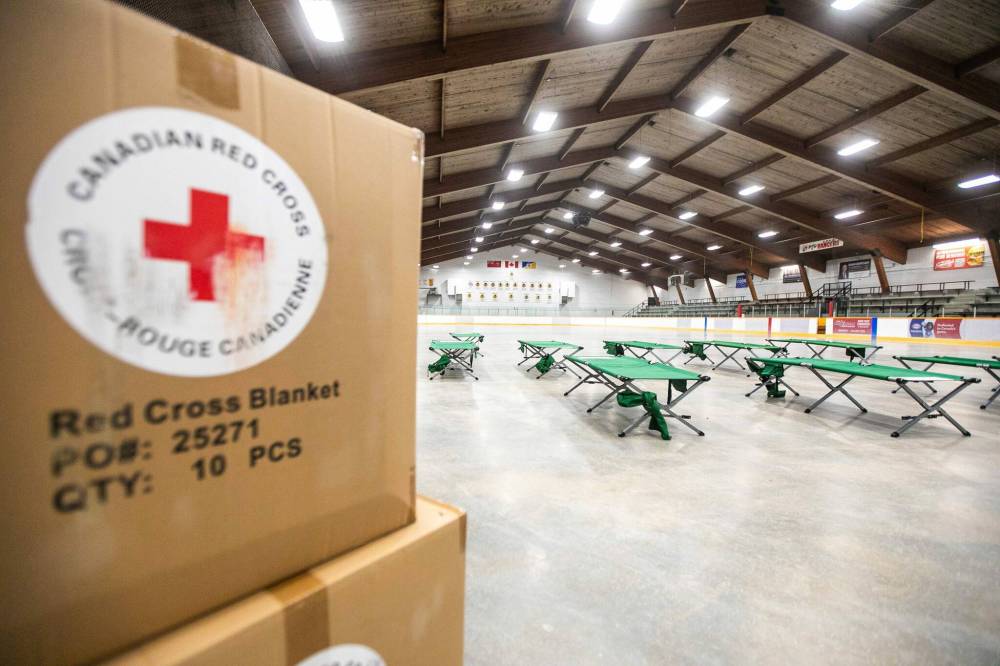
“At a time like this, we’ll band together as the people of Winnipeg to support those who have to come south, and leave their properties and belongings behind,” Mayor Scott Gillingham said. “Manitobans do this. We rally together in times of crisis.”
An evacuation of Flin Flon, home to about 5,000 people, continued past a midnight deadline and well into Thursday.
“There are stragglers, and they are being searched out by the police and other officials to make sure we empty the community,” Mayor George Fontaine said. “We don’t need any extra people around. They have to go.”
The city’s hospital was evacuated, he said.
In a Facebook post later Thursday, Monias said the community’s nursing station was shut down and nurses “were pulled,” leaving the remaining residents “completely abandoned” without medical services, aside from a doctor who stayed behind.
He called on Indigenous Services Canada to provide help.
“We have pregnant women who now have nowhere to go,” he wrote. “We’re setting up a makeshift clinic in one of our command centre offices to deliver babies, treat wounds and provide essential care.”
Manitoba is stepping up its fire and travel restrictions as of 8 a.m. Friday due to extreme fire danger and a high number of human-caused fires.
Hiking trails and water routes in all provincial parks will be closed until further notice.
Kinew urged people not to start fires of any kind.
Minister of Emergency Management and Community Resilience Eleanor Olszewski approved the province’s request for emergency assistance Thursday morning. She said the federal government was working to provide all necessary resources to Manitoba.
Evacuation orders are currently in place for Flin Flon, Lynn Lake, Sherridon, Mathias Colomb First Nation and Pimicikimak Cree Nation.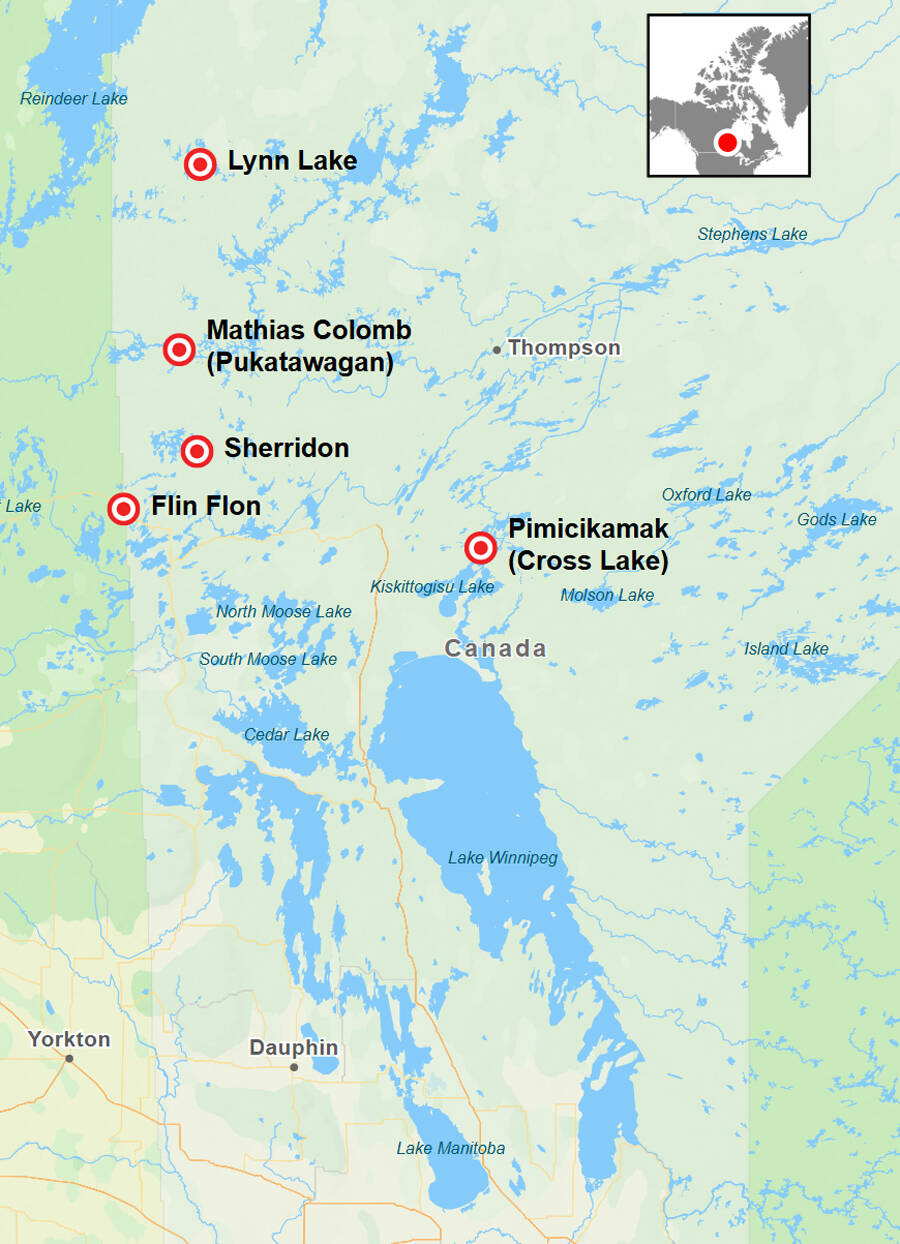
Residents of other communities, including Lynn Lake, Marcel Colomb First Nation and Sherridon, were also forced to flee fires this week.
The Manitoba Wildfire Service reported 22 fires across Manitoba as of Thursday, including 13 that were out of control, amid extremely dry conditions.
About 200,000 hectares of land have burned this year, nearly triple the current annual average. The total area is more than four times the size of Winnipeg.
Evacuees were scattered across Manitoba in the homes of family and friends, hotels, shelters or camping trailers. Many fled with few belongings, prompting Manitobans to step up with offers of clothing, food or other necessities.
Kinew said donating money to the Canadian Red Cross’ wildfires appeal is the best way to help.
Luc Mullinder, the Red Cross’ vice-president for Manitoba, said the organization will support evacuees as long as it takes. He encouraged all evacuees to register.
“Any contribution people make to the wildfires appeal goes immediately to the ongoing relief — providing people with financial assistance, providing support to evacuees and other host communities — and eventually realizing and helping out with recovery efforts, and also building future preparedness plans,” Mullinder said.
Kinew said the province is giving cheques to evacuees to help them buy essentials.
Matthew LaRosa and his stepdaughter were exhausted after pulling into Winnipeg at 1:30 a.m. Thursday, about nine hours after they fled Flin Flon. They are staying with his mother, Lisa, in the capital.
MIKE DEAL / FREE PRESS Matthew LaRosa, an evacuee from Flin Flon, said he arrived in Winnipeg at about 1:30 a.m. Thursday.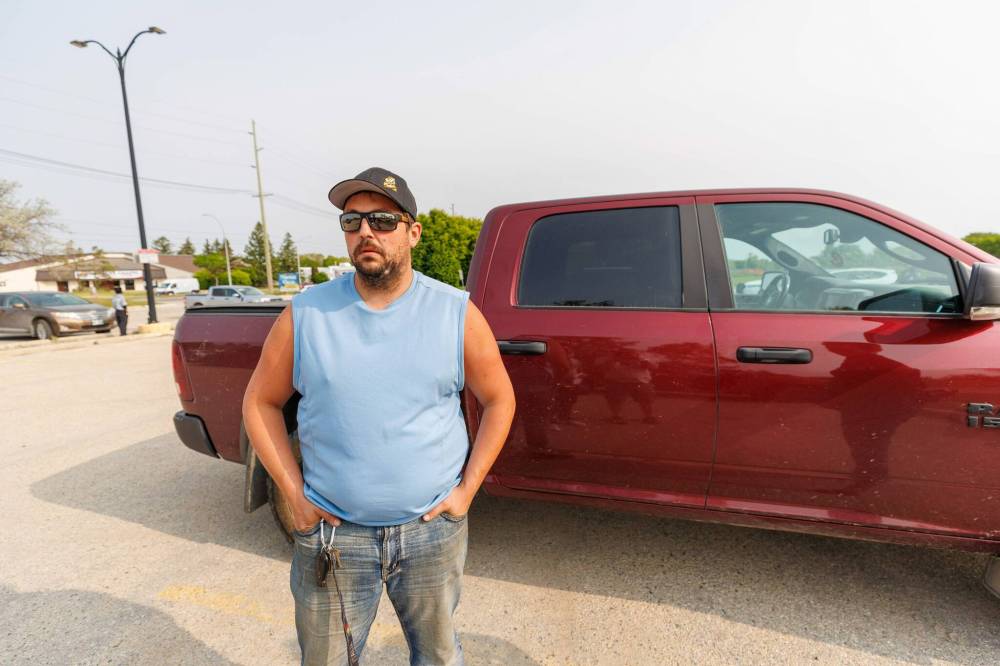
“My biggest priority was keeping (my stepdaughter) safe. Everything else can be replaced,” LaRosa said outside the Billy Mosienko Arena, which the province and Red Cross turned into a reception centre for evacuees. “When we got the evac notice, it was, ‘Go to the house, grab everything, load the truck and get out of town.’”
LaRosa said he was surprised the provincial state of emergency wasn’t called sooner given the severity of wildfires.
A group of evacuees from Mathias Colomb appeared tired and stressed after landing in Winnipeg on Thursday afternoon. One of the evacuees paused, when asked how she felt, as the group boarded a charter bus outside Perimeter Aviation on Ferry Road.
“Not good, I’ll tell you that much,” she said, before being driven to the reception centre at Billy Mosienko Arena.
On the far side of the air field, Hercules planes landed at the Royal Canadian Air Force’s 17 Wing Winnipeg base. Aircraft from Winnipeg and Trenton, Ont., were involved, a CAF spokesperson said.
MIKAELA MACKENZIE / FREE PRESS Evacuees from Pukatawagan arrive in Winnipeg as part of the largest evacuation in Manitoba since 25,000 fled the Flood of the Century in 1997.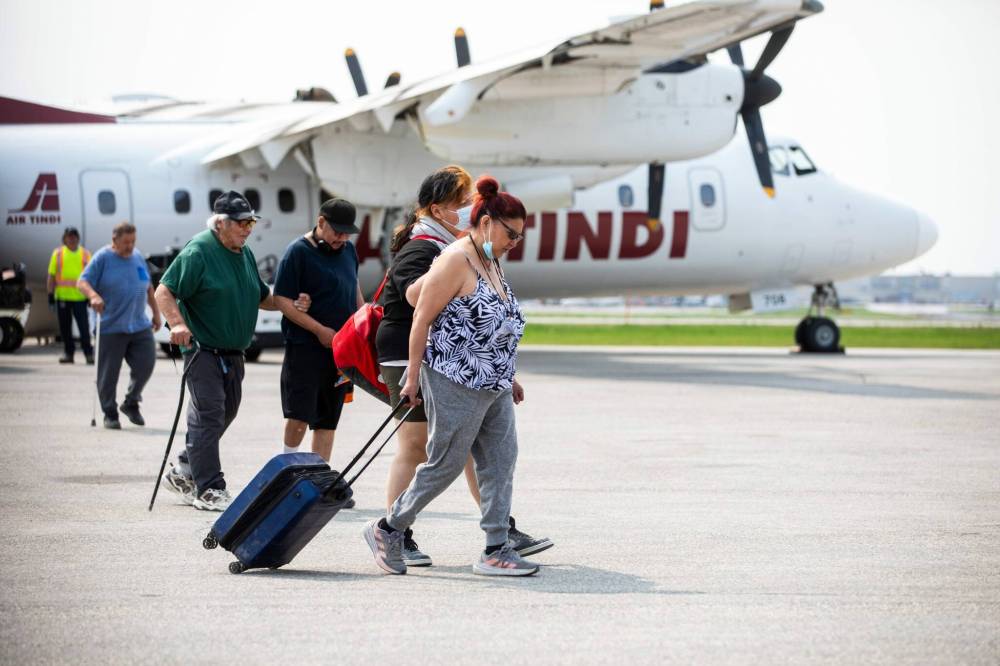
Evacuee Jeff Mckay was in Norway House after fleeing Pimicikamak with his daughters, grandson and a cousin’s two pet budgies.
It took them seven hours to reach the ferry — it is normally a 75-minute drive — due to the logjam of vehicles.
“I’m stressed. We’re stuck in Norway House and we can’t go anywhere until they open the roads,” he said.
Mckay, who was prepared to put his daughters on an evacuation flight to Winnipeg, said he is hoping he can drive south to the capital sometime soon.
“I just want to be able to get out,” he said.
Many of the 17,000-plus evacuees are from First Nation communities. Garrison Settee, grand chief of Manitoba Keewatinowi Okimakanak Inc., which represents northern First Nations, urged governments to ensure the “unprecedented crisis” is met with adequate and prompt supports.
“This is about ensuring that everyone that has been evacuated will arrive at a place where they feel safe and that their needs are looked after,” he told a news conference.
Pimicikimak began a preliminary evacuation to get vulnerable residents to safety May 23. The fire then moved closer to populated areas.
Monias said federal support was slow to come to the First Nation, while the evacuation escalated. He said he hit a “bureaucratic wall” while asking for help earlier.
Kinew said he is in contact with leaders of affected communities.
Many evacuees are constituents of Churchill-Keewatinook Aski MP Rebecca Chartrand, who said she is regularly checking in with Kinew and community leaders.
Some of her loved ones have been impacted by wildfires.
“It’s definitely a scary time. You can hear it, when you’re talking to people,” Chartrand, the new minister of northern and Arctic affairs, said from Ottawa. “I had a hard time sleeping last night, just concerned about people’s well-being.”
“When we got the evac notice, it was, ‘Go to the house, grab everything, load the truck and get out of town.'”–Matthew LaRosa
A separate fire was burning just south of Sherridon, said Sheryl Matheson, deputy mayor and president of the Northern Association of Community Councils.
“It’s right there. It’s in our backyard,” said Matheson, who is among the evacuees staying in Dauphin.
Matheson pleaded with the province to send aerial support to fight the fire. She praised Manitoba Wildfire Service staff and a 13-member team from Sherridon who were doing what they could to protect homes.
“They can’t even see what’s coming because there is no aerial support,” Matheson said.
Firefighting resources in Manitoba have been stretched while responding to large, unpredictable fires for weeks. Crews from Alberta, B.C., New Brunswick, Saskatchewan and Parks Canada are helping.
The largest fire continued to be a a blaze, measuring more than 124,000 hectares, near Bird River and Nopiming Provincial Park in eastern Manitoba, where some evacuees have been displaced for more than two weeks.
Two people died in a fire that started northeast of Lac du Bonnet on May 13.
MIKE DEAL / FREE PRESS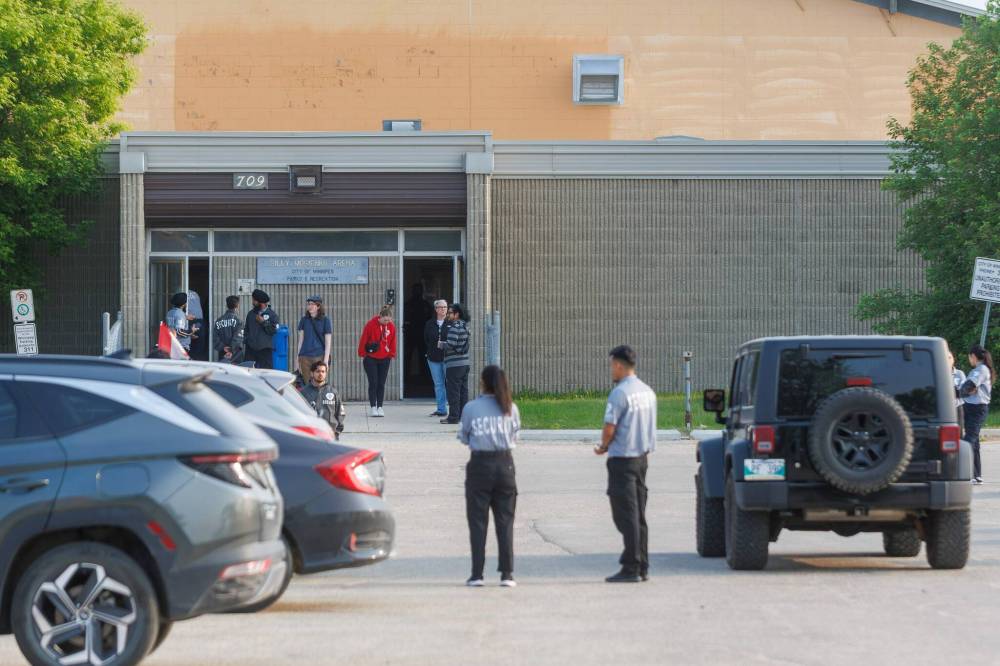
In the north, plumes of smoke from fires near Flin Flon, Pimicikamak and Sherridon were so thick and visibility was so poor that water bombers or helicopters were unable to get into the air to attack the flames, officials said.
Monias said firefighters had to pull back from a blaze near Pimicikamak because conditions, including “mini-tornadoes” and fireballs, were too dangerous.
Ground crews were using hoses, sprinklers and other means in a bid to protect structures in communities threatened by fire.
Firefighters from communities throughout the province were headed north to join the fight. Fontaine said any additional resources were welcome.
“We need all hands on deck,” he said.
RCMP sent extra officers to evacuated communities to staff roadblocks and conduct patrols.
— with files from Nicole Buffie, Tyler Searle, Joyanne Pursaga and Malak Abas
chris.kitching@freepress.mb.ca

Chris Kitching is a general assignment reporter at the Free Press. He began his newspaper career in 2001, with stops in Winnipeg, Toronto and London, England, along the way. After returning to Winnipeg, he joined the Free Press in 2021, and now covers a little bit of everything for the newspaper. Read more about Chris.
Every piece of reporting Chris produces is reviewed by an editing team before it is posted online or published in print — part of the Free Press‘s tradition, since 1872, of producing reliable independent journalism. Read more about Free Press’s history and mandate, and learn how our newsroom operates.
Our newsroom depends on a growing audience of readers to power our journalism. If you are not a paid reader, please consider becoming a subscriber.
Our newsroom depends on its audience of readers to power our journalism. Thank you for your support.
History
Updated on Thursday, May 29, 2025 10:38 AM CDT: Adds photos
Updated on Thursday, May 29, 2025 11:07 AM CDT: Adds more comments from evacuees; revises photo captions; removes photo
Updated on Thursday, May 29, 2025 11:07 AM CDT: Adds comments from Flin Flon mayor
Updated on Thursday, May 29, 2025 11:07 AM CDT: Adds sidebar on Pimicikimak and more photos; minor edits
Updated on Thursday, May 29, 2025 11:07 AM CDT: Adds Sherridon deputy mayor’s comments to sidebar
Updated on Thursday, May 29, 2025 6:17 PM CDT: Adds details, photos.













